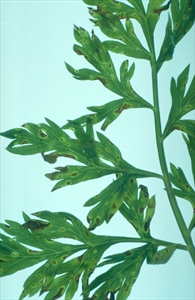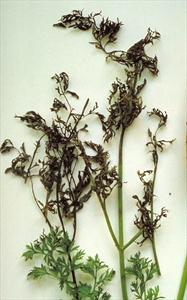Carrot leaf spot, Alternaria leaf spot of carrot
Pacific Pests, Pathogens, Weeds & Pesticides - Online edition
Pacific Pests, Pathogens, Weeds & Pesticides
Carrot leaf spot (135)
Alternaria dauci. Note, another fungus, Cercospora carotae, produces similar symptoms.
Asia, Africa, North, South and Central America, the Caribbean, Europe, Oceania. The leaf blight has been recorded from Australia, Cook Islands, Fiji, French Polynesia, New Caledonia, New Zealand, Papua New Guinea, Samoa, Tonga, and Vanuatu.
Members of the carrot or parsley family, Apiaceae (or Umbelliferae): mostly carrot, but also celery, dill, parsley, parsnip, wild carrot.
Older leaves are attacked first. Dark grey to brown spots, angular, with yellow margins, occur on the leaves and petioles (Photo 1). Under favourable conditions the spots merge and the leaves rapidly blacken, wither and die (Photos 2-4). Spores spread from the older leaves to the younger ones, which also become infected. The fungus also causes a seedling pre- or post-emergence damping-off (see Fact Sheet no. 47).
Alternaria survives after harvest on crop remains in the soil; it also survives between crops on and perhaps inside seed. Tests suggest that infection occurs in about 20% of the seed. Seed infection can lead to damping-off of seedlings. Spread over short distances is in wind-driven rain, and on seed over long distances.
Note, a similar disease is caused by another fungus, Cercospora carotae. Circular tan or grey spots are produced on the leaves and leaf stalks, and during humid weather these merge resulting in a blight.
The fungus that causes the disease is present in all areas where the crop is grown, and it can cause serious economic loss during rainy weather. The disease starts on the older leaves and rapidly spreads to those that are younger, resulting in rapid death and blackening of the foliage; this is called a blight.
Look for the small dark leaf spots surrounded by yellow halos. However, it is difficult to tell the difference between Alternaria dauci and Cercospora carotae. Look at the spots: those of Alternaria are dark-brown to black, with clear yellow halos, and dark centres; the spots of Cercospora are light brown (tan coloured), and circular.
CULTURAL CONTROL
Before planting:
- Use seed that is of high quality, certified free from Alternaria and Cercospora.
- Alternatively, treat in hot water at 50°C for 25-30 minutes.
- Grow seedlings in soilless or pasteurized media in clean trays. Check regularly for signs of disease, and discard any plants with symptoms.
- Do not plant carrots too densely in the row; otherwise, the high humidity and prolonged leaf wetness favour the disease.
After harvest:
- Remove crop debris after harvest to prevent continued sporulation.
- Use crop rotations of 3 years or more.
RESISTANT VARIETIES
There are tolerant varieties of carrot.
CHEMICAL CONTROL
Seed treatment: Dust seed with thiram or captan fungicides to prevent seedling damping-off.
In the field: Fungicides are commonly used to control this disease, and protectants (e.g., iprodione, copper formulations, mancozeb and chlorothalonil), and systemic products (e.g., those in the strobilurin and triazole groups), are used.
____________________
When using a pesticide, always wear protective clothing and follow the instructions on the product label, such as dosage, timing of application, and pre-harvest interval. Recommendations will vary with the crop and system of cultivation. Expert advice on the most appropriate pesticides to use should always be sought from local agricultural authorities.
AUTHOR Grahame Jackson
Information (and Photo 1) is from Diseases of vegetable crops in Australia (2010). Editors, Denis Persley, et al.. CSIRO Publishing; and Gerlach WWP (1988) Plant diseases of Western Samoa. Samoan German Crop Protection Project, Deutsche Gesellschaft für Technische Zusammenarbeit (GTZ) Gmbh, Germany; and Leaf blight of carrots (2016) Agriculture and Food. Department of Primary Industries and Regional Development. Government of Western Government. (https://www.agric.wa.gov.au/carrots/leaf-blight-carrots#:~:text=Carrot%20leaf%20blight%20is%20a,dauci%20and%20occasionally%20by%20A.&text=Another%20fungus%2C%20Cercospora%20carotae%2C%20causes,severe%20cases%20can%20defoliate%20crops); and from Carrot, Alternaria leaf blight (undated) The Center for Agriculture, Food and the Environment. University of Massachusetts Amherst. (https://ag.umass.edu/vegetable/fact-sheets/carrot-alternaria-leaf-blight). Photo 2 Kohler F, et al. (1997) Diseases of cultivated crops in Pacific Island countries. South Pacific Commission. Pirie Printers Pty Limited, Canberra, Australia. Photo 3 David B. Langston University of Georgia. Photo 4 McKenzie E (2013) Alternaria dauci PaDIL - (http://www.padil.gov.au).
Produced with support from the Australian Centre for International Agricultural Research under project PC/2010/090: Strengthening integrated crop management research in the Pacific Islands in support of sustainable intensification of high-value crop production, implemented by the University of Queensland and the Secretariat of the Pacific Community.







